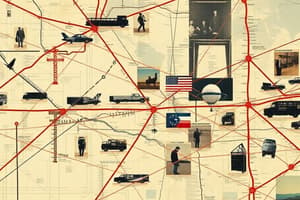Podcast
Questions and Answers
What term describes locations that provide entry to a transport network?
What term describes locations that provide entry to a transport network?
- Connections
- Nodes (correct)
- Routes
- Modes
Which of the following is NOT a type of transportation mode mentioned?
Which of the following is NOT a type of transportation mode mentioned?
- Water
- Air
- Land
- Digital (correct)
What key feature enhances the ability of a transportation network to efficiently move goods and people?
What key feature enhances the ability of a transportation network to efficiently move goods and people?
- Convenience
- Public Ownership
- Environmental Sustainability
- Connectivity (correct)
Which characteristic is related to the rules or laws ensuring reliability and safety in transportation?
Which characteristic is related to the rules or laws ensuring reliability and safety in transportation?
What is the term for the ease of movement from one place to another in transportation?
What is the term for the ease of movement from one place to another in transportation?
Flashcards are hidden until you start studying
Study Notes
Nodes vs Modes
- Nodes are specific locations within a transport network, essential for starting or ending journeys.
- Key examples of nodes include MRT stations, airports, interchanges, and harbors.
- Network & Routes refer to the connections formed by nodes and the paths travelers take between them.
- Modes denote different methods of transportation categorized into three primary types: land, air, and water.
Connections between Locations
- Transportation facilitates the movement of People and Goods, making it vital for trade and daily commuting.
Transportation Features
- Accessibility is the ease with which individuals can travel from one location to another.
- Connectivity refers to the overall linkage among various transport nodes and routes.
- Entry points into the transport network can be classified as Minor, with three notable entry points.
Characteristics of Transportation
- Density of Network impacts overall traffic flow and service frequency.
- Various Modes are employed within the transportation system (land, water, air).
- Infrastructure can be categorized as either public or private, influencing motorized and shared transportation options.
- Coverage affects the reach of transport services across regions.
- Frequency pertains to how often transport services operate, affecting traveler convenience.
- Capacity relates to the volume of passengers or goods that can be transported at a time.
- Environmental sustainability is a critical factor in modern transportation policies, aiming to minimize ecological impact.
- Convenience impacts user experience, influencing transportation choices.
Policies for Travelling
- Transportation policies are designed to ensure key factors such as Reliability, Safety, and Convenience for users.
- Examples of safety regulations include wearing helmets, adhering to speed limits, using protective gear, maintaining valid driving licenses, and prohibiting jaywalking.
Studying That Suits You
Use AI to generate personalized quizzes and flashcards to suit your learning preferences.




